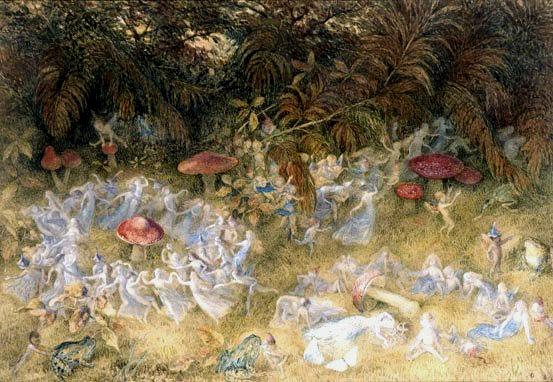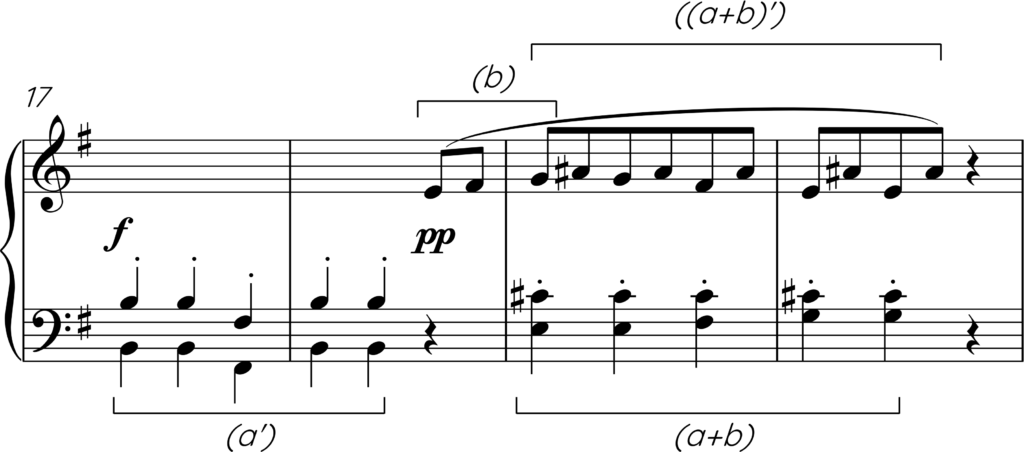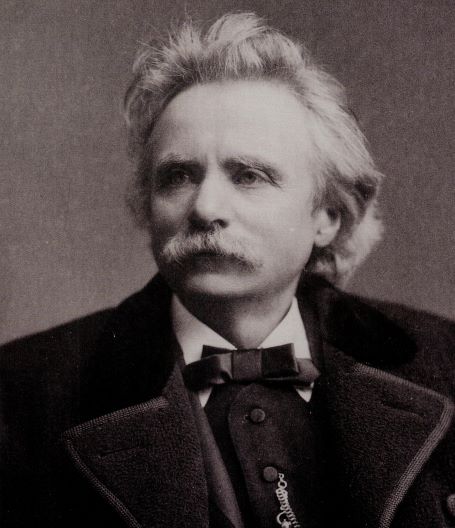Inspired by the folklore of his native Norway, Grieg’s ‘Elf-Dance’ is a scherzo-like movement which exemplifies many aspects of Grieg’s early piano writing. Most often female, elves in Norse legend are mainly to be encountered at night or in the mists of early morning, dancing in groups, leaving behind ‘elf-circles’. Frequently associated with illness or bad luck, should a human happen to observe their dance, while it feels to them that only a few minutes have passed, in reality many years have gone by. In this depiction of one such dance, there is indeed both a ‘circularity’ and a hint of menace.
Like most of Grieg’s Lyric Pieces, ‘Elf-Dance’ eschews the developmental principles associated with Germanic sonata-form, consisting of paragraphs that are repeated and varied in pitch or in details of melodic contour. (This manner of construction, too, can be seen as a result of Grieg’s interest in Scandinavian folk-music.) Much of the content of these larger paragraphs, it will be seen, are in fact drawn from a small number of ideas presented in the first four bars.

Pianistically speaking, the piece is idiomatic, effectively exploiting contrasts of register and tone-colour to enhance the imagery suggested by the title. The figuration is gratefully placed, allowing the performer to achieve the requisite delicacy of touch without any technical awkwardness. This is perhaps unsurprising, given that the pieces comprising what was to become the first of Grieg’s ten volumes of Lyric Pieces began life as teaching pieces for the composer’s own use.
Analytical commentary
The scherzo-like ‘Elf-Dance’ is in E minor, and remains within this tonal orbit throughout, relying heavily on diminished chords to create an atmosphere of mystery and danger. The form might be described as a binary-rondo hybrid:
| A | bars 1-8 | |
| A | bars 9-16 | bars 1-8, repeated exactly |
| B | bars 17-30 | transformation of rhythmic and melodic motifs from A section |
| A | bars 31-38 | bars 1-8, repeated exactly |
| B | bars 39-52 | bars 17-30, repeated exactly |
| A | bars 53-60 | bars 1-8, repeated exactly |
| Coda | bars 61-72 | based on A |
However, both A and B sections rely heavily on a limited number of motifs introduced in the first four bars, which are either varied or, as it were, superimposed; that is, the rhythmic profile of one motif is combined with the melodic contour of another. While this shared material creates a feeling of a unified whole, the sectional divisions outlined above represent paragraphs of contrasting mood and harmonic emphasis.

The A section presents two ideas, whose rhythmic figures also feature in the B section. The first, a five-crotchet pattern, consists of repeated tonic chords separated at the midpoint by one submediant chord. The second is a delicately ascending quaver figure, accompanied below by a similar chordal pattern, now shorn of its final crotchet, featuring an anacrustic conjunct third which is also to feature prominently in the B section (see ex. 1). Harmonically, the movement in this second phrase is from tonic to subdominant. The melody having ascended to the dominant at the end of bar 4, bars 5-6 repeat bars 1-2, transposed upwards into the dominant minor. For the concluding phrase of the paragraph, the left hand takes the melody, which again features the conjunct rising third figure (see ex. 2). At bar 8, the harmony moves into the dominant major; this open-ended progression opens up both the repeat of the A section (bars 9-16), and the beginning of the B section.

The B section represents the more menacing aspect of the music’s mythical subject by means of more widely contrasting dynamics, a shift to a lower register of the keyboard, and the harmonic ambiguity of diminished-seventh chords, which feature prominently throughout this section. This ambiguity extends, in fact, to the key of the entire section. The continuation in the dominant area is implicit from the melodic emphasis upon Bs and F-sharps; but there is no suggestion of major or minor tonality from bar 17 until the preparation of the perfect cadence in the global tonic in bar 30.
The melodic descending perfect fifth from bar 8, F-sharp to B, is inverted for the opening phrase of this section. The phrase, the hands playing an octave apart, borrows its outline from the opening five-chord motif, repeated Bs now divided at the midpoint by F-sharp. The oscillating quaver accompaniment from the right hand in bars 7-8 is now combined with the anacrustic conjunct third. The same rising third is presented in augmentation in the bass, again borrowing the five-crotchet rhythmic figure (bars 19-20), while the lower notes of the right-hand oscillating quavers reverse the pattern, in contrary motion with the bass, again simulating the ‘circularity’ of the elves’ dance (see ex. 3).

Following an exact repeat of this phrase (bars 21-24), the contrary-motion pattern is repeated, transposed up a minor third (the construction of the diminished seventh chord, of course, means that while the musical material has ascended in pitch, the harmony remains uniform). One further repeat (bars 27-8) is compressed, the anacrustic conjunct minor third now a major second filled in chromatically, again falling but now joined by the left hand in similar motion, taking the music through three relatively static bars (bars 28-30), the harmony moving through a French sixth, to a dominant chord, the suspended fourth in the top voice resolving to the leading-note and then seamlessly connecting to the next statement of the A section at bar 31.
From this point until bar 61, there is no change in the material. The brief coda evolves naturally from the first A-section phrase, taking the ascending figure, with its characteristic semitonal appoggiatura, through subdominant, Neapolitan, and dominant-seventh harmony, before one final reworking of the opening chordal idea. The five-chord figure is extended by two chords, indeed two statements of the idea are telescoped together, the final two chords of the first assuming the role of the first two chords of the second. This extended phrase affords the opportunity for the inner voices to move apart, then together, on the third and sixth chords of the phrase respectively—one final circular image before the final tonic chords ascend into the upper register.
Although bars 31-60 repeat bars 1-30 literally, there is a slight variation in the order in which the material is presented. The two statements of the A section, at first presented in succession, now frame the B section. As the coda begins with the first four-bar phrase of the A section, it might seem that this is unnecessary as the three-bar cadential pattern with which the B section ends would have prepared for the coda, in terms of texture and harmony, just as effectively. However, given the coda’s brevity, the preceding eight bars balance its mood; without this preparation, the coda would seem rather too brief and perfunctory. It is as if, enchanted once more by the magic of the dance, the baleful mood of the B section is forgotten, before the dancers disappear from sight along with the final glimmers of moonlight before the dawn.

